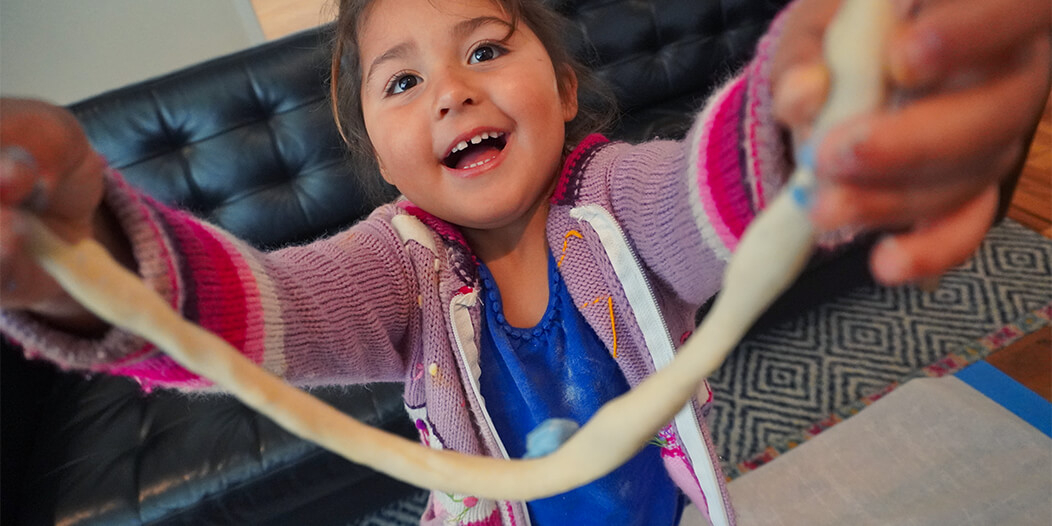
Why Play with Playdough
Posted: September 16, 2020 | Updated: September 16, 2020
Created by: Ms. Sylvia
I have vague memories of playing with playdough as a child, but the way that I really know I spent time with it is the visceral reaction I feel when I open one of the little jars of commercial playdough and smell that distinctive scent waft over me. With that smell, I’m hit by the memory of that grainy texture and my inner excitement at the limitless possibilities of what I could build, as well as (to my disappointment) the memory of its salty, salty taste. I know from my teaching experience that the desire to nibble a bit of playdough to see how it tastes is widespread, but I still wish the taste weren’t something I could remember so well. Still, I am grateful for my childhood explorations of playdough. We all need to build with our hands and playdough was one of my favorite mediums.
Why play with Playdough?
Fond childhood memories are great, but what is the value of playing with playdough? There are actually many reasons why playdough activities are not only fun, but beneficial. Here are a few:
Fine Motor Skills
Shaping playdough develops fine motor skills by strengthening the small muscles in the hand. Why are these important? For a very long answer, I suggest reading neurologist Frank Wilson’s excellent book, The Hand: How Its Use Shapes the Brain, Language, and Human Culture. If you’re short on time here’s the quick answer: a strong, flexible hand helps develop a strong, flexible mind and sets the stage for math and literacy skills.
Imagination
With playdough, you can build so much! It can be wonderful to explore the different possibilities, and every time we explore, we strengthen our imagination. When I was little, I remember building playdough villages, full of people and their stories. What will you build?
Strengthens Larger Muscle Groups
Just as writing is truly powered by shoulder muscles, kneading and forming playdough can subtly strengthen a young child’s larger muscle groups, particularly in the shoulders and wrists, while also strengthening the smaller muscles of the hand and finger (see reason 1!)
Problem Solving
There’s nothing like completing work on your playdough flower, only to have it fall and break apart from its own weight. Fixing your creation then involves a great deal of problem solving skills. What is the maximum weight a playdough flower can sustain? How can the flower become more sturdy? All sorts of considerations need to be taken, and every new creative vision brings new problems to be solved.
Resilience and Growth Mindset
Alongside problem solving, playdough can also help us to be resilient. If the first thing we try doesn’t work, do we walk away and cry? (Even as adults, maybe!) Hopefully, we return to the table and try again. This can teach children not only that they have the capacity to work through challenges, but also that mistakes are a natural part of the process and that they can lead to new creative directions. Framing mistakes or problems in a growth mindset context can help your child beyond the art table and into their future learning.
Communication
When we create something, we often want to share about it! Most children love to talk about what they’re building. By talking about their creations, they build their language skills and their ability to express their thoughts, needs, and concerns. They also can learn to advocate for themselves by asking for what they need while building.
Cooperative Play
If more than one person is using the playdough, it becomes an excellent opportunity to explore cooperative play. It can be very tempting (sooooo very tempting) to squish a playdough sculpture. It is even more tempting when that sculpture is not your own. However, if you squish someone else’s creation, satisfying though that may be, they are going to have some feelings about it. Big feelings. Learning to navigate these temptations and their potential consequences is part of cooperative play. So is sharing, communicating, and building positive language around others’ work. There is a lot of social-emotional learning to explore in cooperative play, and playdough can be an excellent vehicle for it.
Academic Skills
Depending on how you use playdough it can be a wonderful vehicle for academic learning by reinforcing descriptive language as children communicate about their creations and by establishing number sense and a practical application for simple math (dividing two different colors of dough into three parts each, for example, then sharing one of each color). Playdough can be used to form letters or entire spelling words. It can also be used to summarize a story by building a vignette and can be expanded to emphasize sequencing of events by creating different vignettes that must be described in order. There are so many different ways to learn with playdough.